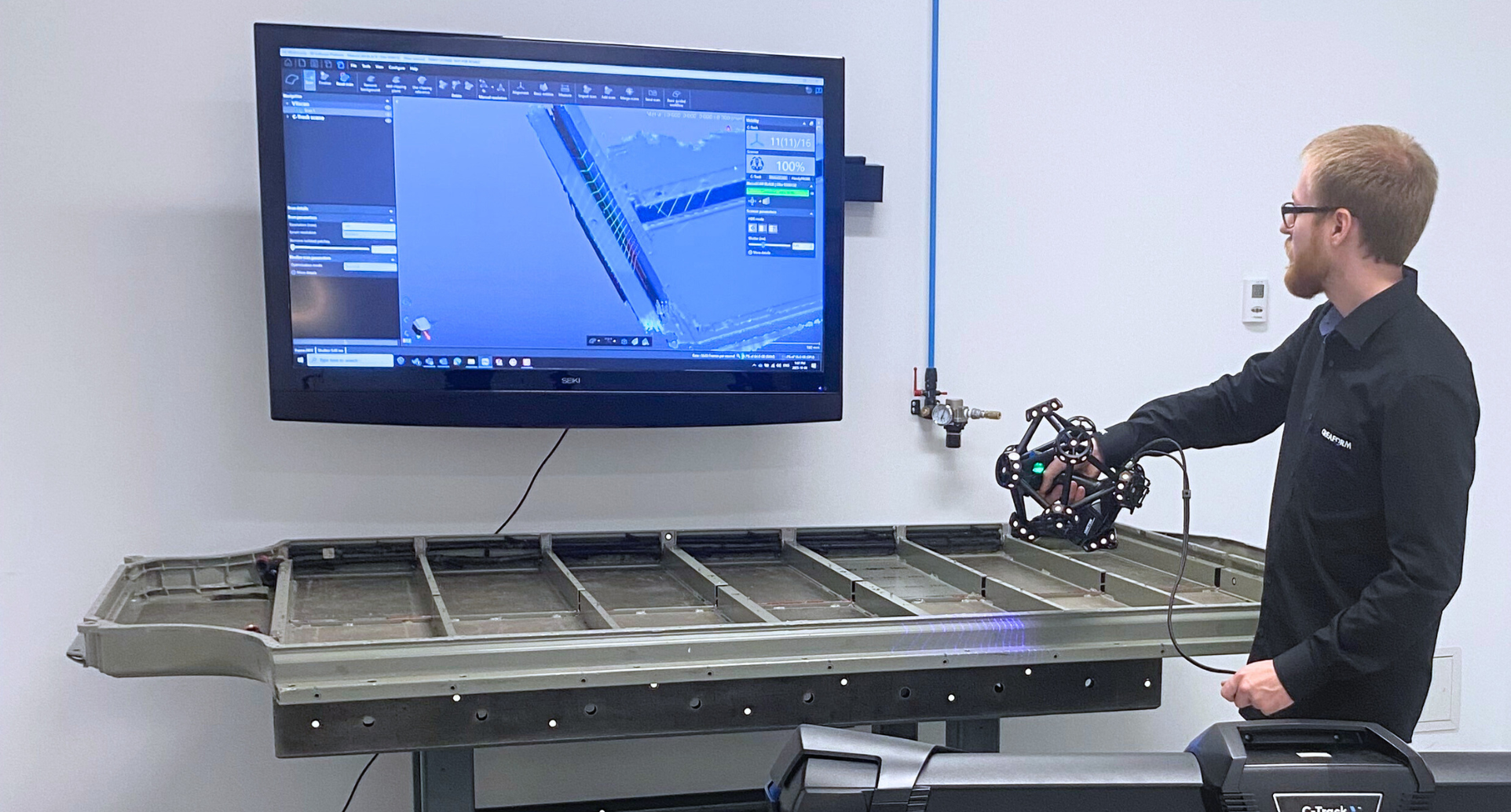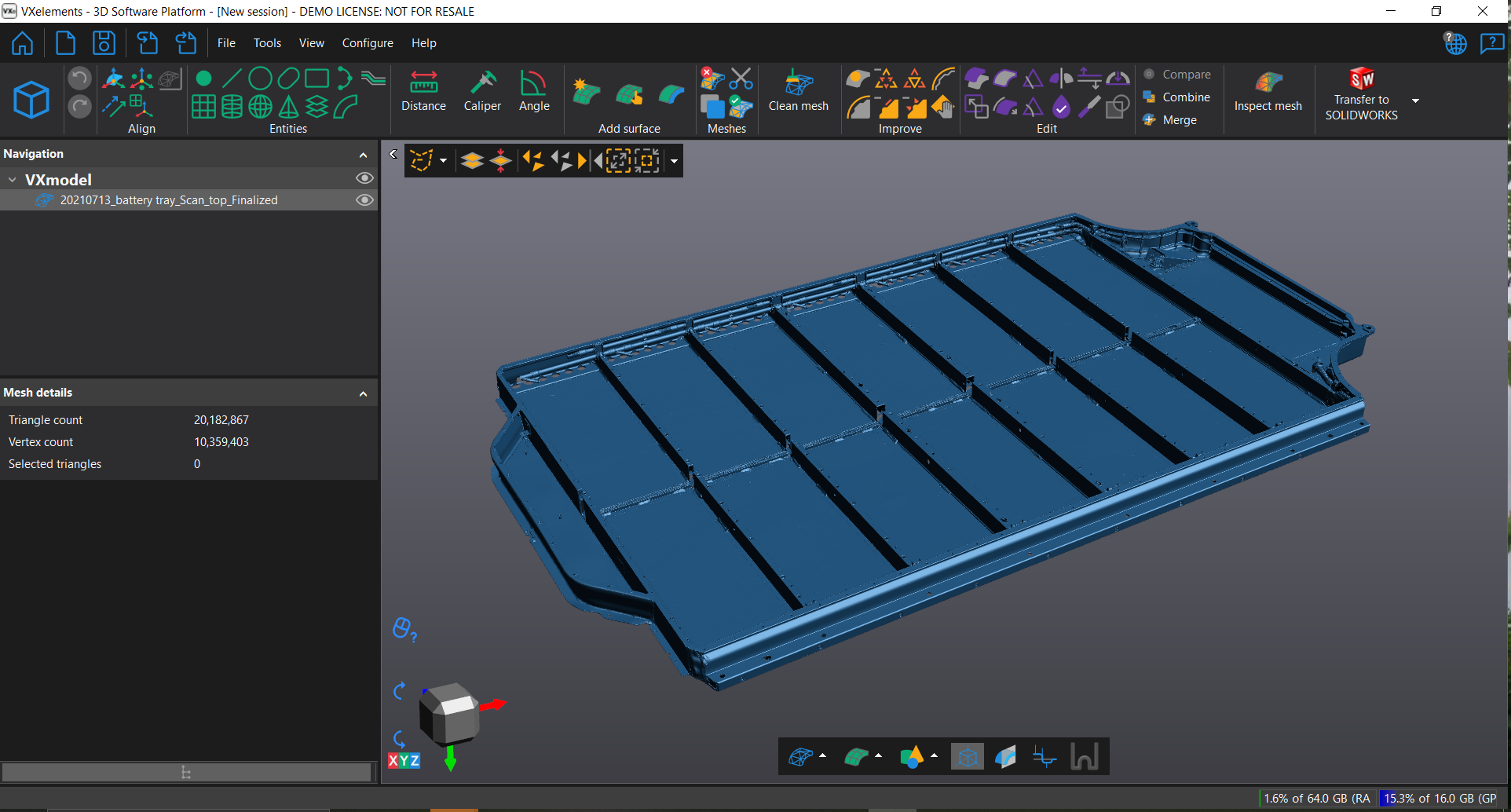Exit this form
Are you sure you want to quit this form?
Battery trays are structural elements that enclose and safeguard the battery modules and their supporting electrical and thermal management systems. Battery modules must precisely fit into the battery tray, which must fit seamlessly within the vehicle's chassis. Variations in dimensions can result in improper assembly or misalignment. Specifically, flatness errors can lead to bad welds and loose connections to the power system (disrupting the electricity flow) or to the cooling system (altering the heat transfer). Such deficiencies will sooner or later affect the battery's performance and longevity and reduce the car's efficiency.

Precise, fast and certified quality inspection are of the utmost importance for EV manufacturers.
Many quality managers prefer the coordinate measuring machine (CMM) to perform their quality controls – and for good reason. CMMs are the most accurate metrology equipment for quality inspection. However, achieving this high level of accuracy comes with certain inconveniences. CMMs are often in high demand, busy with all types of inspection. They are located in dedicated metrology labs, necessitating a lot of programming, setup, and back-and-forth with the production line. All these extra steps congest and slow the inspection process, impairing the production throughput.
It is not any better to opt for traditional instruments to overcome the CMM’s lack of availability and speed, as the quality control of battery trays requires highly accurate measurements to meet the industry’s performance criteria and tight tolerances.
Battery trays compose the EV’s main structural part, and they are often produced in harsh environments with ubiquitous oscillations, vibrations, and thermal variations. This is not an ideal location for performing highly accurate measurements. On top of that, they also feature extrusions that can be laborious to measure with traditional tools.
Moving the battery trays to the metrology lab remains a significant hurdle that is both demanding and time-consuming. Opting for measuring arms is not optimal either because the technology does not allow for measuring an entire battery tray in a single position, instead requiring leapfrogs and additional steps in the measuring process.

Even on the shop floor, it is possible to obtain the necessary accuracy needed for the EV industry.
Battery trays are typically made from lightweight and durable materials, such as aluminum, steel, or composite materials, which are mostly reflective. Any measurement technology involving white or blue light will reflect off these shiny surfaces, impacting measurement results. Therefore, a surface treatment (powder application) is required to counter this effect. Such inconvenient part preparation means one more step in the inspection process, which means more time to manufacture and deliver the parts.
The technology behind EVs is relatively new, at least compared to internal combustion engine (ICE) vehicles. Battery trays did not exist 15 years ago, meaning that this part calls for new manufacturing and quality control processes, new choices of materials and components, a selection of new suppliers, and the hiring and training of new employees. That's a lot to worry about for OEMs and tier-1 and tier-2 suppliers who must pivot from ICE to EV. The same applies to new players making their debut in the auto industry.
Accuracy: ISO 17025-certified optical 3D scanners have the required reach to measure large parts in a single scan. Featuring dynamic referencing, they are designed for use on the shop floor, offering measurement accuracy insensitive to environmental instabilities. This means battery trays can remain on the shop floor for quality control, as these portable and highly accurate 3D scanners can be brought onto the production floor and measure large sizes quickly and easily.
Speed: Metrology-grade 3D scanners are indeed the best alternative for quality inspections occurring on the shop floor. Less expensive than CMMs, they measure significantly faster, require less training and programming time, and contribute to reducing inspection time and accelerating production throughput.
Versatility: Measuring battery trays (or any shiny part) without part preparation is the most versatile option for EV part manufacturers. Blue laser 3D scanners master these difficult, contrasting finishes with no surface treatment required. Their data acquisition proficiency is particularly notable with reflective materials, such as those used to produce EV battery trays. They offer better performance and better readings than any other measuring solution available on the market.
Ease of use: Inspection software must have an intuitive interface that is accessible, easy to learn, and simple to integrate and operate. In addition, modules must offer complete toolset and features for conducting all inspection workflows without compromising measurement quality or GD&T requirements. This means that anyone can use them regardless of expertise or experience level.
Metrology-grade 3D scanners MetraSCAN 3D and HandySCAN 3D|BLACK Series and inspection software VXinspect and PolyWorks are good examples of such accurate, fast, versatile, and easy-to-use 3D scanning solutions.
The unmatched speed and versatility of laser 3D scanners contribute to reducing the inspection time, which impacts the overall efficiency of the manufacturing process.
With portable, fast, and accurate 3D scanners, inspection time can drastically be reduced from hours to minutes—all with an accuracy of 0.025 mm. This efficiency leads to more parts being produced and inspected in less time or, in other words, faster customer delivery and accelerated time-to-market, which makes the EV part manufacturer more competitive in the market.
With 3D scanning, EV part manufacturers can inspect their large battery trays directly on the shop floor without compromising accuracy or requiring surface preparation. In addition, laser 3D scanners require less training, handling, and programming time than the CMM, and they acquire data more quickly, which helps accelerate inspection time.
When opting for a proven and trusted 3D scanning solution, EV parts manufacturers perform their inspections directly on the shop floor. They accelerate their inspection time while maintaining their quality standards. Thus, they gain efficiency, which leads inevitably to higher production throughput.